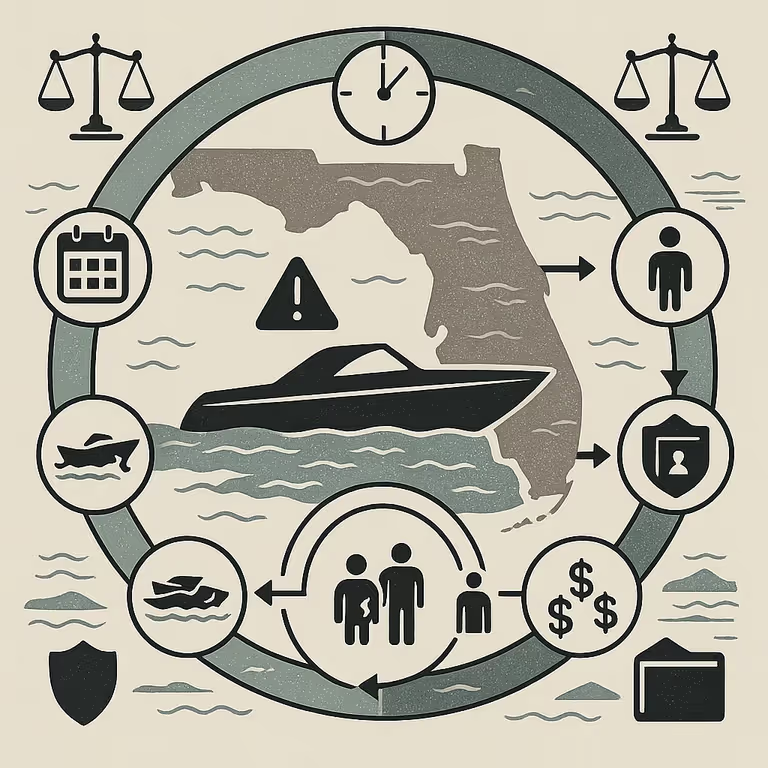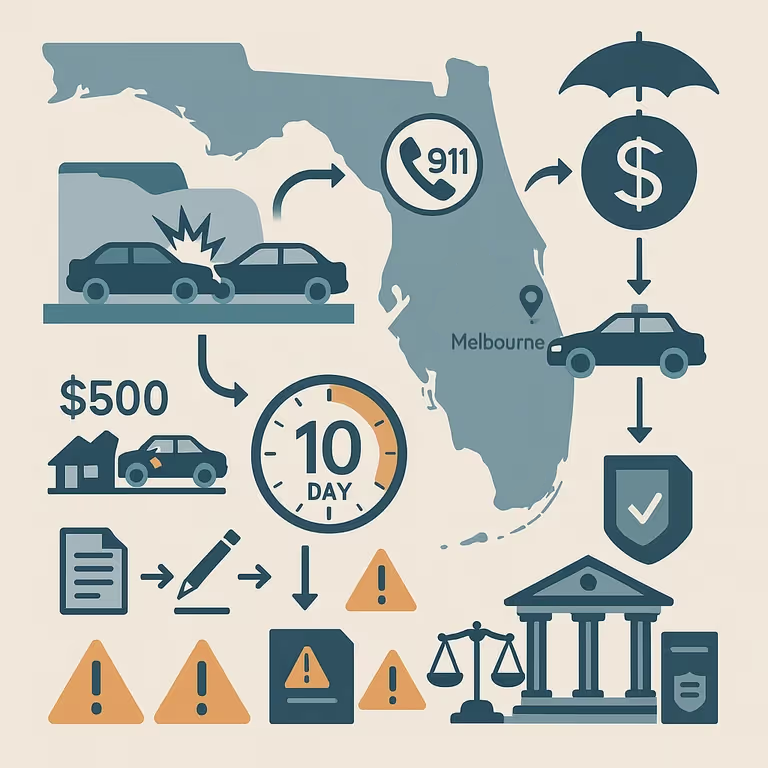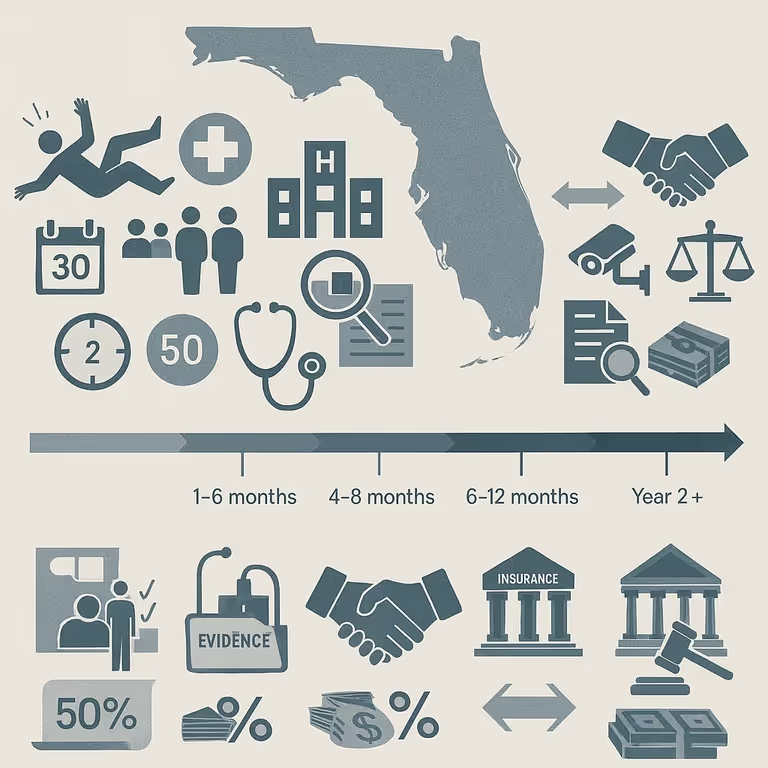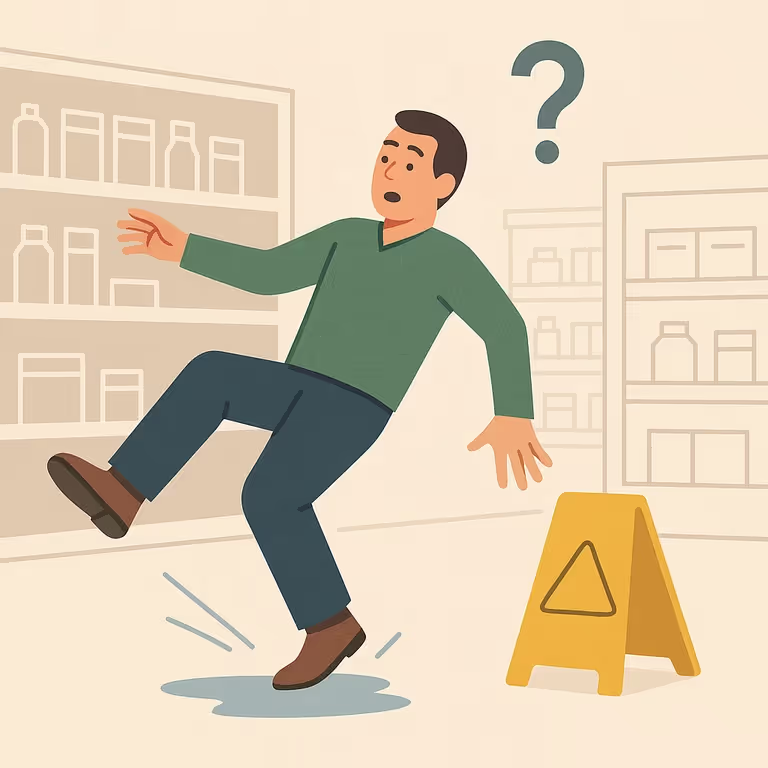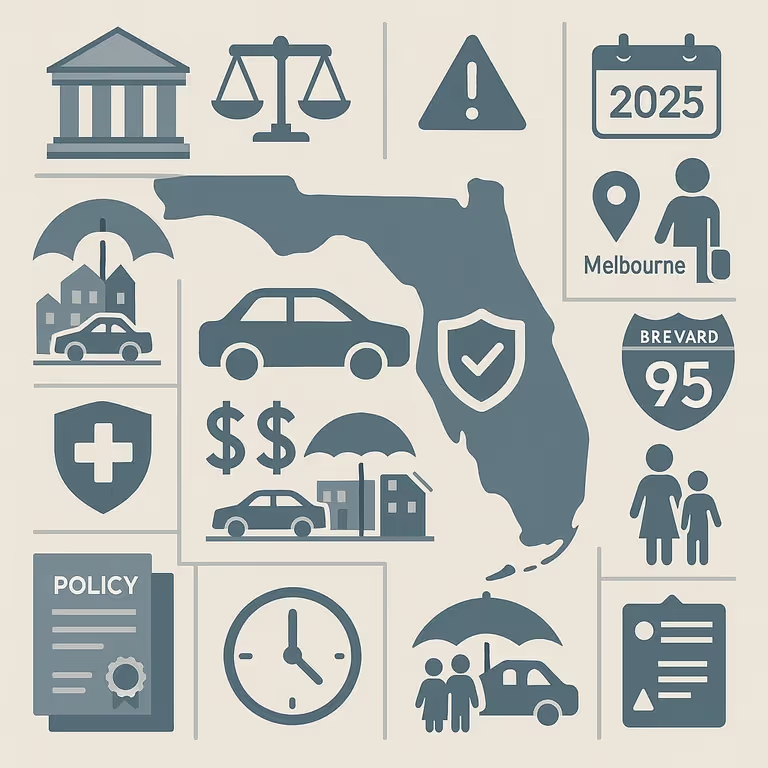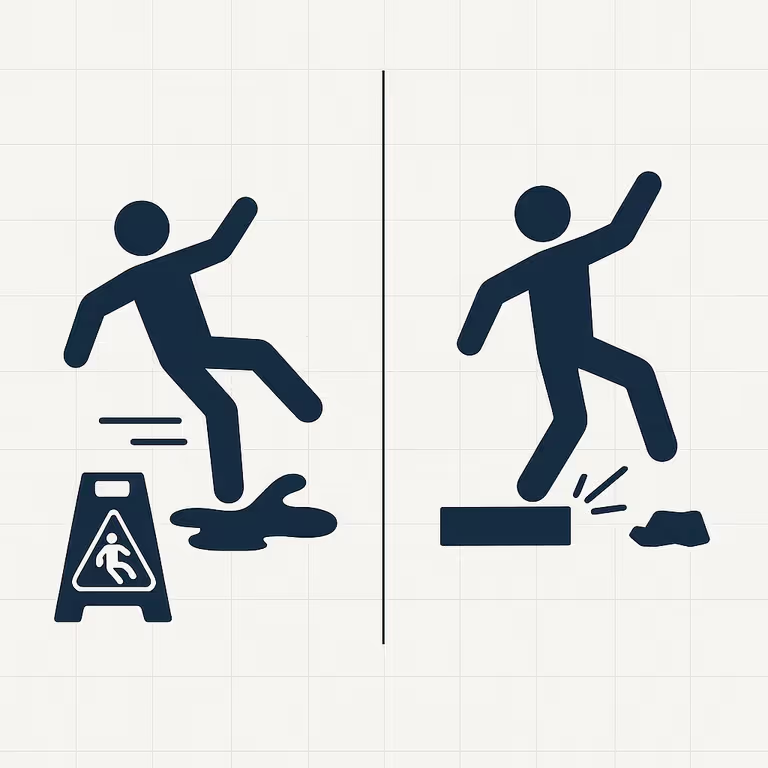Is Driving with One Headlight Illegal in Florida?
Florida law requires two working headlights at all times. Learn about penalties, accident liability, and your rights after headlight violations.

- Florida law requires all vehicles to have two functioning headlights regardless of time of day or weather conditions.
- Headlight violations can affect car accident claims but don't automatically determine fault in crashes.
- Equipment violations typically cost $100-150 total with court fees and may impact insurance rates.
Worried About Your Injury Case? We'll Review It - Free!


If you've noticed a burned-out headlight on your vehicle, you might wonder whether it's safe or legal to drive with just one working headlight in Florida. The answer is straightforward: It is illegal to drive with only one headlight in Florida. Florida law specifically requires all motor vehicles to have at least two functioning headlights, and driving with a broken or missing headlight can result in a traffic citation.
Is It Illegal to Drive with One Headlight in Florida?
Florida Statute 316.2395 clearly states that every motor vehicle must be equipped with at least two headlamps. This means that whether one of your headlights has burned out, been damaged in an accident, or simply stopped working, driving your vehicle on Florida roads violates state equipment requirements.
Many drivers assume they can get by with one headlight, especially during daytime hours when visibility seems adequate. However, Florida law doesn't make exceptions based on the time of day or weather conditions. The two-headlight requirement applies at all times, regardless of whether you're driving during the day or night.
This requirement exists for important safety reasons. Headlights serve multiple purposes beyond just illuminating the road ahead. They help other drivers judge the width and distance of your vehicle, particularly in low-light conditions. A vehicle with only one working headlight can be mistaken for a motorcycle or may create confusion about your vehicle's size and position on the road.
Understanding this law helps Florida drivers avoid unnecessary traffic stops and citations. More importantly, it ensures that all vehicles on the road meet basic safety equipment standards that protect everyone sharing Florida's highways and streets.

Understanding Florida's Two-Headlamp Rule and Usage Requirements
Florida's vehicle lighting laws are designed to ensure that all drivers can see and be seen on the road. These requirements go beyond just having headlights. They establish specific standards for when lights must be used and how they should function.
The Two-Headlamp Rule
Florida Statute 316.220 establishes the minimum headlamp requirement for all motor vehicles. The law states that "(1) Every motor vehicle shall be equipped with at least two headlamps." This requirement is absolute and applies to all passenger cars, trucks, and other motor vehicles operating on Florida roads.
The statute doesn't provide exceptions for temporary malfunctions or partial failures. If one of your headlights stops working, you're technically in violation of Florida law from the moment you begin driving, regardless of the reason for the headlight failure.
When Headlights Must Be Used
Florida law requires drivers to use headlights during specific conditions beyond just nighttime driving. According to Florida Statute 316.217, headlights must be turned on:
- Between sunset and sunrise
- During periods of reduced visibility, including fog, rain, or smoke
- When windshield wipers are in use due to weather conditions
- In any situation where persons or vehicles cannot be clearly seen at a distance of 1,000 feet
This means that having two functioning headlights becomes even more critical during Florida's frequent afternoon thunderstorms or morning fog conditions common in many parts of the state.
Equipment Standards and Maintenance Requirements
Florida law also requires that headlights meet certain brightness and positioning standards. The headlights must be properly aimed and produce adequate illumination without causing dangerous glare for oncoming drivers. While the law requires at least two headlamps, it doesn't prohibit additional lighting as long as those lights comply with state regulations.
Vehicle owners are responsible for maintaining their headlights in working order. This includes replacing burned-out bulbs promptly and ensuring that headlight lenses are clean and unobstructed. Florida doesn't require periodic vehicle inspections like some other states, which places the responsibility for equipment maintenance squarely on the vehicle owner.
Common Misconceptions About Florida Headlight Laws
Many Florida drivers hold misconceptions about when it's acceptable to drive with one headlight. Some believe that driving during daylight hours excuses the violation, but Florida law makes no such exception. Others think that using hazard lights or fog lights can substitute for a missing headlight, but these alternative lights don't meet the legal requirement for headlamps.
Another common misunderstanding involves rental vehicles or borrowed cars. Some drivers assume they're not responsible for equipment violations in vehicles they don't own. However, the person driving the vehicle is typically responsible for ensuring it meets legal requirements, regardless of ownership.

Understanding Florida's Two-Headlamp Rule and Usage Requirements
Understanding the potential consequences of driving with one headlight can help Florida drivers make informed decisions about vehicle maintenance and repair priorities. While a headlight violation might seem minor, it can lead to various complications beyond just a simple fine.
Traffic Citation Process and Fines
When a police officer stops you for driving with one headlight, you'll typically receive a noncriminal traffic infraction citation. In Florida, equipment violations like defective headlights are generally classified as noncriminal infractions rather than criminal offenses.
The base fine for a headlight violation in Florida is typically around $30, though this amount can vary by county due to additional court costs and administrative fees. By the time all fees are added, drivers often pay between $100 and $150 for a single headlight violation. These amounts can increase if the violation occurs in a construction zone or school zone.
Some jurisdictions offer "fix-it ticket" programs where drivers can avoid paying the fine by proving they've repaired the headlight within a specified timeframe, usually 30 days. However, these programs aren't available in all Florida counties, and drivers may still be required to pay court costs even when the underlying fine is waived.
Points on License and Insurance Implications
Most headlight violations in Florida don't result in points being added to your driver's license, which is good news for most drivers. However, Florida's point system can still affect drivers who accumulate multiple violations or who have other traffic infractions on their record.
While a single headlight violation may not directly impact your driving record, insurance companies may still consider any traffic citation when calculating premiums. Some insurers review motor vehicle records during policy renewals and may increase rates for drivers with multiple citations, even for equipment violations.
How Law Enforcement Handles These Violations
Florida law enforcement officers have discretion in how they handle headlight violations. Some factors that may influence whether you receive a warning versus a citation include:
- Time of day: Officers may be more likely to issue citations for headlight violations during nighttime hours when the safety impact is greater
- Weather conditions: Violations during rain, fog, or other reduced visibility conditions may be treated more seriously
- Driver cooperation: A respectful attitude and valid driver's license can sometimes result in a warning instead of a citation
- Other violations: If officers discover additional infractions during the traffic stop, they're more likely to issue citations for all violations
Steps to Take If You're Cited
If you receive a citation for driving with one headlight, you have several options. You can pay the fine, which constitutes an admission of guilt, or you can contest the citation in court. Before deciding, consider whether your jurisdiction offers a fix-it ticket program that might allow you to avoid or reduce the penalty.
If you choose to contest the citation, you'll need to appear in court on the scheduled date or hire an attorney to represent you. Many drivers find that for simple equipment violations, the cost of legal representation exceeds the potential savings from fighting the ticket.
The most important step after receiving any equipment violation is to fix the underlying problem immediately. Continuing to drive with defective equipment increases the risk of additional citations and potentially more serious consequences if you're involved in an accident.

How Equipment Violations Impact Car Accident Claims
When a headlight violation intersects with a car accident, the legal implications become more complex than a simple traffic citation. Understanding how equipment violations can impact accident claims is crucial for Florida drivers, especially those who may find themselves involved in crashes while their vehicles have maintenance issues.
Understanding Florida's Comparative Negligence Law
Florida follows a pure comparative negligence system, which means that fault in an accident can be divided among all parties involved based on their respective contributions to the crash. Under Florida Statute 768.81, each party's financial responsibility corresponds to their percentage of fault, even if one party is 99% at fault and the other only 1%.
A headlight violation doesn't automatically make you at fault for an accident, but it can be considered as evidence when determining each party's degree of negligence. Insurance companies and courts examine all factors that may have contributed to the accident, including any equipment violations that might have played a role in the crash.
The key question becomes whether the defective headlight actually contributed to the accident. If the crash occurred during daylight hours on a clear day, a broken headlight likely had no impact on the accident's cause. However, if visibility was a factor during dawn, dusk, rain, or nighttime conditions, the headlight violation could affect the fault determination.
Equipment Violations as Evidence in Accidents
Insurance adjusters and attorneys routinely investigate whether any traffic law violations occurred at the time of an accident. A headlight violation creates a paper trail that can be used as evidence, particularly if:
- The accident occurred during conditions requiring headlight use
- Visibility or vehicle recognition played a role in the crash
- The other driver claims they didn't see your vehicle clearly
- The accident involved a rear-end collision where your vehicle's visibility might have been a factor
It's important to understand that having a headlight violation doesn't automatically mean you're at fault for an accident. The violation must have actually contributed to the crash in some meaningful way. For example, if another driver runs a red light and hits your car during broad daylight, your broken headlight wouldn't be considered a contributing factor.
What Insurance Companies Look For
Insurance companies employ experienced adjusters who investigate accident claims thoroughly. When reviewing a claim involving a vehicle with equipment violations, they typically examine:
- Time and weather conditions: Was it dark, raining, foggy, or otherwise challenging for visibility?
- Location details: Did the accident occur on a well-lit street or a dark highway?
- Type of collision: Could better visibility have prevented or reduced the severity of the crash?
- Police reports: Do official reports mention the equipment violation or suggest it played a role?
- Witness statements: Do witnesses indicate that vehicle visibility was a factor?
Insurance companies have a financial incentive to minimize their payouts, so they may attempt to use equipment violations to shift fault to the other party. However, they must demonstrate that the violation actually contributed to the accident, not merely that it existed at the time of the crash.
Protecting Your Interests After an Accident
If you've been involved in an accident where equipment violations are being questioned, several steps can protect your interests:
- Document everything: Take photos of all vehicles, the accident scene, lighting conditions, and road conditions
- Get witness information: Collect contact details for anyone who saw the accident occur
- Be careful with statements: Avoid admitting fault or discussing equipment issues with other drivers or insurance adjusters
- Seek medical attention: Address any injuries promptly and maintain documentation of all medical treatment
- Report accurately: Provide factual information to police and your insurance company without speculating about fault
If you've been injured in a car accident in Florida where you weren't at fault, consulting with an experienced personal injury attorney can help you understand your rights and options. At Douglas R. Beam P.A., we've been helping Brevard County residents navigate complex accident claims since 1988, with over $1 billion in verdicts and settlements for our clients. Contact our Melbourne office for a free consultation to discuss your case.

Maintenance Tips and Legal Guidance
Proper vehicle maintenance is the best way to avoid headlight violations and ensure your safety on Florida's roads. Regular attention to your vehicle's lighting systems can prevent unexpected failures and costly citations.
Regular Inspection and Replacement
Make headlight inspection part of your routine vehicle maintenance. Check both headlights weekly, especially if you frequently drive during dawn, dusk, or nighttime hours. Look for:
- Burned-out bulbs: The most common headlight problem
- Dim or flickering lights: Often indicates bulbs nearing the end of their lifespan
- Moisture inside the headlight housing: Can cause bulbs to fail prematurely
- Cracked or cloudy lenses: Reduces light output and may indicate other issues
- Loose or damaged connections: Can cause intermittent failures
Consider replacing both headlights at the same time when one fails. Headlight bulbs typically have similar lifespans, and replacing both ensures consistent light output and color temperature. This practice also prevents the inconvenience and potential citation risk of having the second bulb fail shortly after replacing the first.
What to Do If You Get a Ticket
If you receive a citation for a headlight violation, take these immediate steps:
- Fix the problem immediately: Replace the defective headlight as soon as possible to prevent additional citations
- Keep documentation: Save receipts for parts and repair work, as some jurisdictions allow these as evidence for dismissal
- Research local programs: Check if your county offers fix-it ticket programs that might reduce or eliminate the fine
- Consider your options: Decide whether to pay the fine or contest the citation in court
- Review your driving record: Multiple violations can have cumulative effects on insurance rates
When to Seek Legal Consultation
While most headlight violations are straightforward matters that don't require legal assistance, certain situations might warrant professional consultation:
- Multiple violations: If you've received several equipment citations, an attorney can help address patterns that might affect your driving record
- Accident involvement: If a headlight violation is connected to an accident claim, legal guidance can protect your interests
- Commercial drivers: CDL holders face different standards and consequences that may require specialized legal advice
- Insurance disputes: If your insurance company is using an equipment violation to deny or reduce a claim
For Florida drivers who have been injured in accidents where they weren't at fault, understanding your rights is crucial regardless of any equipment violations. Insurance companies sometimes attempt to use minor infractions to shift blame and reduce their financial responsibility.
Frequently Asked Questions
Can I drive during the day with one headlight?
No, Florida law requires two functioning headlights at all times, regardless of whether it's day or night. The statute doesn't provide exceptions based on lighting conditions or time of day.
What if my headlight burns out while I'm driving?
If a headlight fails while you're driving, complete your trip safely and replace the bulb as soon as possible. While the violation technically begins when the light fails, most officers use discretion for truly unavoidable situations.
How much is the fine for a broken headlight in Florida?
The base fine is typically around $30, but with court costs and administrative fees, the total often ranges from $100 to $150. Amounts vary by county and can be higher in certain zones.
Will a headlight violation affect my car insurance?
While headlight violations typically don't add points to your license, insurance companies may consider any traffic citation when calculating premiums during policy renewals.
Can I get a headlight ticket dismissed?
Some Florida counties offer fix-it ticket programs where you can avoid the fine by proving you've repaired the headlight within a specified timeframe. Check with your local court clerk for available options.
If someone hits me and I have a broken headlight, am I automatically at fault?
No, having a broken headlight doesn't automatically make you at fault. Florida's comparative negligence system considers whether the equipment violation actually contributed to the accident. The broken headlight would only affect fault determination if it played a role in causing the crash.
When do I need to use headlights in Florida?
Florida law requires headlights between sunset and sunrise, during reduced visibility conditions (fog, rain, smoke), when using windshield wipers due to weather, and anytime persons or vehicles cannot be clearly seen at 1,000 feet.
For more information about Florida car accident laws and your rights as an injured driver, explore our legal resources or call us at (321) 723-6591 for a free consultation.
Sources and Further Reading
- Florida Statute 316.2395 - Minimum Headlamp Requirements – Florida Senate
- Florida Statute 316.217 - Headlight Usage Requirements – Florida Senate
- Florida Statute 768.81 - Comparative Negligence Law – Florida Senate
- Traffic Citation Procedures – Seminole County Clerk
- Traffic Violation Information – Florida Courts
- 2024 Florida Legislative Updates – Blue360 Media
This article provides general information and is not a substitute for legal advice. Laws can change, and the details of your situation matter. For personalized guidance, please contact a qualified Florida personal injury attorney.
Not Sure What To Do Next? We Can Help – Fast & Free.
Worried About Your Injury Case?
We'll Review It - Free
Don’t miss an article
Florida law, local insights, and the occasional dog pic.
Delivered straight to your inbox.
More articles
Browse all articlesFree Case Review
Get a complimentary review of your case

.webp)

